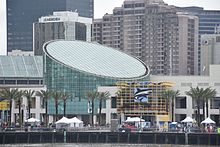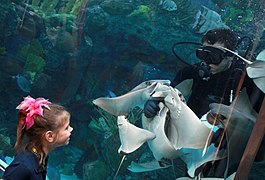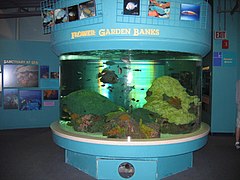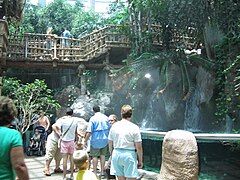The Saint Louis Zoo, officially known as the Saint Louis Zoological Park, is a zoo in Forest Park, St. Louis, Missouri. It is recognized as a leading zoo in animal management, research, conservation, and education. The zoo is accredited by the Association of Zoos and Aquariums (AZA). Admission is free based on a public subsidy from a cultural tax district, the Metropolitan Zoological Park and Museum District (ZMD); fees are charged for some special attractions. A special feature is the 2 ft narrow-gauge Emerson Zooline Railroad with passenger trains pulled by Chance Rides C.P. Huntington locomotives that encircle the zoo, stopping at the more popular attractions.

The National Aquarium – also known as National Aquarium in Baltimore and formerly known as Baltimore Aquarium – is a non-profit public aquarium located at 501 East Pratt Street on Pier 3 in the Inner Harbor area of downtown Baltimore, Maryland in the United States. Constructed during a period of urban renewal in Baltimore, the aquarium opened on August 8, 1981. The aquarium has an annual attendance of 1.5 million visitors and is the largest tourism attraction in the State of Maryland. The aquarium holds more than 2,200,000 US gallons (8,300,000 L) of water, and has more than 17,000 specimens representing over 750 species. The National Aquarium's mission is to inspire conservation of the world's aquatic treasures. The aquarium's stated vision is to confront pressing issues facing global aquatic habitats through pioneering science, conservation, and educational programming.

The Houston Zoo is a 55-acre (22 ha) zoological park located within Hermann Park in Houston, Texas, United States. The zoo houses over 6,000 animals from more than 900 species. It receives around 2 million visitors each year and is the second most visited zoo in the United States, surpassed only by the San Diego Zoo. It is accredited by the Association of Zoos and Aquariums (AZA).

Shedd Aquarium is an indoor public aquarium in Chicago. Opened on May 30, 1930, the 5 million US gal aquarium holds about 32,000 animals and is the third largest aquarium in the Western Hemisphere, after the Georgia Aquarium and Monterey Bay Aquarium.
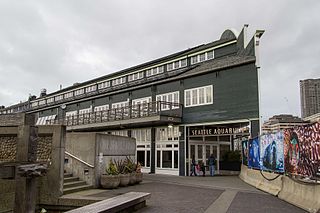
The Seattle Aquarium is a public aquarium in Seattle, Washington, United States, located on Pier 59 on the Elliott Bay waterfront. It opened in 1977 and has been accredited by the Association of Zoos and Aquariums (AZA).

Omaha's Henry Doorly Zoo and Aquarium is a zoo in Omaha, Nebraska. It is accredited by the Association of Zoos and Aquariums and a member of the World Association of Zoos and Aquariums. In August 2014, TripAdvisor rated it the "world's best zoo", ahead of the San Diego Zoo and Loro Parque, based on an algorithmic assimilation of millions of reviews for 275 major zoos worldwide.

Audubon Zoo is an American zoo located in New Orleans, Louisiana. It is part of the Audubon Nature Institute which also manages Audubon Aquarium, Audubon Louisiana Nature Center, Freeport-McMoran Species Survival Center, Audubon Park, and Audubon Coastal Wildlife Network. It covers 58 acres (23 ha) and is home to over 2,000 animals. It is located in a section of Audubon Park in Uptown New Orleans, on the Mississippi River side of Magazine Street. The zoo and park are named in honor of artist and naturalist John James Audubon who lived in New Orleans starting in 1821.

Point Defiance Zoo & Aquarium (PDZA) is the only combined zoo and aquarium in the Pacific Northwest, located in Tacoma, Washington, US, owned by Metro Parks Tacoma. Situated on 29 acres (12 ha) in Tacoma's Point Defiance Park, the zoo and aquarium are home to over 9,000 specimens representing 367 animal species. The zoo was founded in 1905; the aquarium was founded in 1935 near Commencement Bay and relocated within the zoo in 1963. Both are accredited by the Association of Zoos and Aquariums. In Pierce County, Washington, this is said to be one of the most popular tourist destinations, bringing in over more than 600,000 visitors per year.

The New England Aquarium is a nonprofit organization located in Boston, Massachusetts. The species exhibited include harbor and northern fur seals, California sea lions, African and southern rockhopper penguins, giant Pacific octopuses, weedy seadragons, and thousands of saltwater and freshwater fishes. In addition to the main aquarium building, attractions at Central Wharf include the Simons Theatre and the New England Aquarium Whale Watch. More than 1.3 million guests visited the aquarium each year prior to the outbreak of the COVID-19 pandemic.

The ABQ BioPark Aquarium, located in Albuquerque, New Mexico, United States is a facility of the Albuquerque Biological Park and is located next door to the ABQ BioPark Botanic Garden. The ABQ BioPark Aquarium exhibits Gulf of Mexico and South Pacific saltwater species from a variety of habitats, including surf zone, shallow waters, coral reefs, open ocean and deep ocean. The highlight of the aquarium is a 285,000 U.S. gal (1,080,000 L) shark tank with a 38-foot (12 m)-wide, 9-foot (2.7 m)-high, 8-inch (200 mm)-thick acrylic viewing window.

The South Carolina Aquarium, located in Charleston, South Carolina, opened on May 19, 2000, on the historic Charleston Harbor in the former location of the Anson Borough Homes, a public housing project that was closed over soil contamination and flooding concerns. It is home to more than ten thousand plants and animals including North American river otters, loggerhead sea turtles, alligators, great blue herons, owls, lined seahorses, jellyfish, pufferfish, green moray eels, horseshoe crabs, sea stars, pythons, and sharks. The largest exhibit in the zoo is the Great Ocean Tank, which extends from the first to the third floor of the Aquarium and is the deepest tank in North America ; it holds more than 385,000 US gallons (1,460,000 L) of water and contains more than 700 animals. The Aquarium also features a Touch Tank, where patrons may touch horseshoe crabs, Atlantic stingrays, and other marine animals.

The Texas State Aquarium is a nonprofit aquarium located in Corpus Christi, Texas, United States. It aims to promote environmental conservation and rehabilitation of the wildlife of the Gulf of Mexico. It has been accredited by the Association of Zoos and Aquariums (AZA) since 1995. It is the largest aquarium in Texas and one of the largest aquaria in the United States.
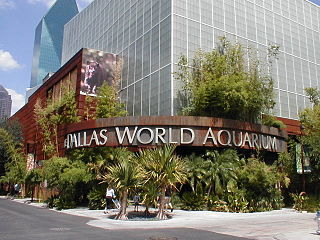
The Dallas World Aquarium is a for-profit aquarium and zoo located in the West End Historic District of Dallas, Texas, USA. It aids conservation and education by housing many animals that are threatened or endangered as part of a cooperative breeding program with other zoos around the world. It has been an accredited member of the Association of Zoos and Aquariums since 1997 and is a member of the World Association of Zoos and Aquariums.

Shark Reef Aquarium is a public aquarium on the Las Vegas Strip in Paradise, Nevada. It is located at and owned by the Mandalay Bay resort. The attraction opened on June 20, 2000. Its main tank is 1,300,000 US gallons (4,900,000 L), one of the largest in North America. The facility is 105,000 sq ft (9,800 m2), and displays numerous species of sharks, rays, fish, reptiles, and marine invertebrates. It also features a shark tunnel. The reef was developed in consultation with the Vancouver Aquarium.

The Virginia Aquarium & Marine Science Center, formerly known as the Virginia Marine Science Museum, is an aquarium and marine science museum located in Virginia Beach, Virginia, just south of Rudee Inlet. The exhibits at the museum are contained in over 800,000 US gallons (3,028,000 L) of fresh and saltwater displays.

The Akron Zoo, officially known as the Akron Zoological Park, is a non-profit zoo located just west of downtown in Akron, Ohio, United States. The zoo sits on 77-acre (31 ha) of which 35-acre (14 ha) are occupied with by habitats, amenities, and support.
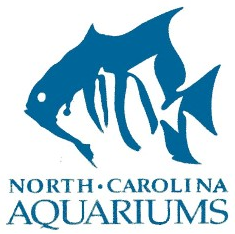
North Carolina Aquariums is a system of three public aquariums located in Kure Beach, Roanoke Island and Pine Knoll Shores. All are operated by the Aquariums Division of the North Carolina Department of Natural and Cultural Resources since 1976 and were accredited by the Association of Zoos and Aquariums. All three aquariums feature dive shows, live animal encounters, and feeding programs.

Sea Life Park Hawaii is a marine mammal park, bird sanctuary and aquarium in Waimānalo near Makapuʻu Point, north of Hanauma Bay on the island of Oahu in Hawaii, United States. The park first opened in 1964, and includes exhibits that let visitors interact with the animals by swimming with dolphins, sea lions, and rays, taking a sea safari in the aquarium, and feeding the sea turtles. The park was acquired in 2008 and is operated by Palace Entertainment, the U.S. subsidiary of Parques Reunidos from Dolphin Discovery, which had acquired it in 2005.

Downtown Aquarium is a public aquarium and restaurant located in Houston, Texas, United States that was developed from two Houston landmarks: Fire Station No. 1 and the Central Waterworks Building. The aquarium is located on a 6-acre (2.4 ha) site at 410 Bagby Street in downtown Houston. It houses over 200 species of aquatic animals in 500,000 US gallons (1,900,000 L) of aquariums. The complex includes two restaurants, a bar, and banquet facilities. It offers programs such as Marine Biologist for a Day, Zoologist for a Day, Sea Safari Camp, overnight stays and more. The education department works with school groups and conducts outreach programs.

The Adventure Aquarium, formerly the Thomas H. Kean New Jersey State Aquarium, is a for-profit educational entertainment attraction operated in Camden, New Jersey on the Delaware River Camden Waterfront by Herschend Family Entertainment. Originally opened in 1992, it re-opened in its current form on May 25, 2005 featuring about 8,000 animals living in varied forms of semi-aquatic, freshwater, and marine habitats. The facility has a total tank volume of over 2 million US gallons (7,600,000 L), and public floor space of 200,000 square feet (19,000 m2).
